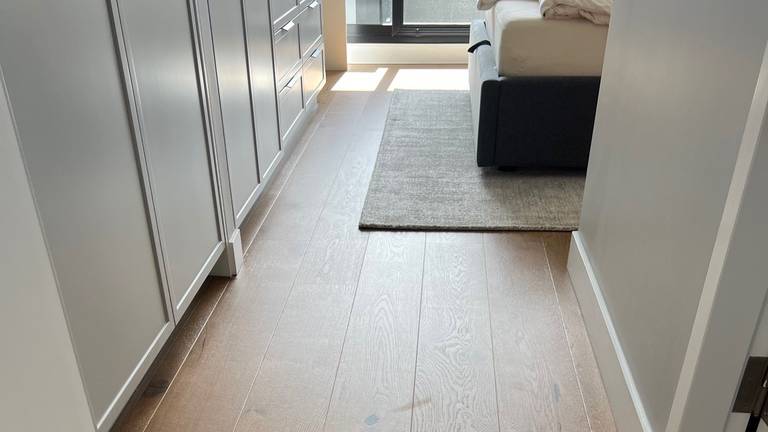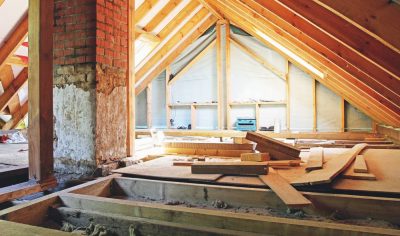- Oneflare /
- Cost Guides /
- Hardwood Flooring

How Much Does Hardwood Flooring Cost?
$95 - $150 per m2 including labour and materials
What's on this page
- Hardwood flooring cost in Australia
- The different types of hardwood flooring and their costs
- Hardwood installation methods and their impact on cost
- Professional vs DIY hardwood flooring installation
- How to save money with hardwood flooring installation
Read Related Hardwood Flooring Articles
How much does hardwood flooring cost in Australia?
Hardwood flooring installation costs $95 to $250 per square metre, including materials and labour.
Key Facts
|
A well-maintained hardwood floor can last over a century, which explains why hardwood flooring costs more upfront but remains one of the most enduring investments for Australian homes.
Wood flooring costs have evolved over time, but on average, installing hardwood flooring in Australia costs between $95 and $250 per square metre, depending on the type of wood, installation method, labour cost, and other factors. Let’s break down everything you need to know.
How much does hardwood flooring installation cost?
| Disclaimer: Oneflare’s cost estimates come from thorough research on industry and third-party rates. Please only use the listed prices as a benchmark when setting your budget. Moreover, as different areas have local taxes and service fees, the rates listed below are subject to change. |
The cost to put hardwood floors depends on two main components: materials and labour. Here’s a quick overview of what you can expect for hardwood floor installation costs in Australia.
| City | Material cost (per m²) | Labour cost (per m²) | Total cost (per m²) |
| Sydney | $55–$160 | $50–$80 | $105–$240 |
| Melbourne | $60–$140 | $45–$80 | $105–$220 |
| Brisbane | $65–$145 | $40–$80 | $105–$225 |
| Perth | $60–$150 | $40–$100 | $100–$250 |
| Adelaide | $60–$140 | $35–$75 | $95–$215 |
These prices typically include basic floor preparation, moisture barrier installation, underlay placement, and standard warranty coverage. Wooden floorboards cost can increase when you factor in additional expenses; floorboards cost per m2 might rise by $25 to $35 for removing existing flooring, plus potential charges for extensive subfloor repairs, custom trim work, or enhanced warranty coverage.
What are the different types of hardwood flooring and their costs?

Newly installed white kitchen cabinetry and sink area. | Source: J & C Cabinets (Vic)
The answer to how much hardwood flooring costs varies by type, as not all hardwood flooring is created equal. Here’s a breakdown of the most common types available in Australia and their average costs:
Solid hardwood
Native Australian hardwoods are popular choices for their durability and local availability. While hardwood timber flooring prices come at various price points, these materials are durable enough for multiple sanding and refinishing cycles. However, hardwood flooring prices might be higher in humid areas.
- Blackbutt is one of the most cost-effective options, ranging from $60 to $90 per m². It offers excellent termite resistance and fire rating, ideal for most residential applications. Its blonde to light brown colour and straight grain pattern allow it to blend seamlessly with most design aesthetics, while its high density provides exceptional durability in high-traffic areas.
- Spotted gum commands a slightly higher price at roughly $80 to $100 per m², but its distinctive grain pattern and natural water resistance make it a favourite for statement floors. This premium is justified by its remarkable dimensional stability in fluctuating humidity conditions, and the unique wavy grain that creates a visually striking, three-dimensional appearance.
- Oak remains a classic choice at $40 to $150 per m² or higher, offering consistent grain patterns and excellent stability. Its wide range of colour options fits many interior styles. That said, the substantial price variation reflects the significant differences between American oak (more affordable) and European oak (premium), as well as between quarter-sawn boards (more expensive but with superior stability and distinctive ray fleck patterns) and plain-sawn options.
Engineered hardwood
Made from a thin layer of hardwood bonded to a plywood base, modern engineered hardwood offers practical advantages at different price points, similar to laminate flooring. These are generally more stable than hardwood with none of hardwood’s weaknesses in humid conditions, but they also have fewer refinishing options than hardwood.
- Standard grade options ($65 to $95 per m²) feature a 2-3mm wear layer and typically come with a residential warranty.
- Solid timber flooring prices for premium grades ($90 to $150 per m²) reflect their enhanced stability and moisture resistance.
- Luxury grades ($110-$150 per m²) provide maximum durability with a thick wear layer that can be refinished multiple times. Some homeowners might also install underfloor heating with engineered hardwoods of this grade.
Recycled/salvaged timber
For environmentally conscious homeowners, reclaimed timber offers unique character at $70 to $140 per m². However, higher costs in some regions and limited availability can offset this unique character.
- Basic grades show more visible history in their appearance. These boards feature distinctive nail holes, saw marks, and varied colouration that showcase their previous life, creating authentic character at the cost of more challenging installation.
- Premium grades offer more consistent aesthetics while maintaining the timber’s story and character. These boards ensure uniform dimensions and better structural integrity while preserving subtle historical markers, making them easier to install and more reliable for high-traffic areas.
| Also read: Which is better: Carpet vs floor tiling |
Hardwood installation methods and their impact on cost

Light hardwood flooring in a room. | Source: Triple Tree Timber Flooring
The choice of installation method significantly affects both immediate costs and long-term performance. There are three main ways hardwood flooring is installed:
Floating installation
This is the quickest and most DIY-friendly method to install your flooring, but it may produce more noise underfoot. Floating installation cost for hardwood flooring is priced at about $30-$70 per m².
Traditional nail-down installation
Most stable of the three; requires a wooden subfloor. Nail-down costs typically range from $40–$60 per m².
Glue-down methods
If you have a polished concrete floor, glue-down works better than most and provides excellent stability, but you might find it harder to make changes later. Glue-down methods usually fall between $45 and $65 per m².
Professional vs DIY hardwood flooring installation

Outdoor timber deck. | Source: Vinny The All Rounder
While installing a hardwood floor yourself might seem like an obvious way to save money, the reality is more complex.
A DIY approach requires significant upfront investment in tools and equipment. Beyond the basic hammer and measuring tape, you’ll need specialised tools like moisture metres to test your subfloor, proper saws for precise cuts, and professional-grade nail guns. These tools alone can cost between $500 and $2,500, and that’s before you’ve even purchased a board of timber.
Time commitment presents another crucial consideration. What might take a professional team 1–2 days could extend to a week or more for a DIY project. You’ll need to factor in time for removing old flooring, preparing the subfloor, and the actual installation process. You might also need some time to install carpeting afterwards.
While the cost of hardwood flooring might seem high initially, professional hardwood floor installation offers significant advantages that justify the investment.
Home renovation specialists who do flooring work bring not just their tools but years of expertise in handling unexpected challenges. They know how to deal with uneven subfloors, understand the importance of proper board selection for a consistent appearance, and ensure optimal pattern matching throughout your space.
Additionally, professional installation typically includes crucial steps that DIYers might overlook, such as proper moisture testing and acclimatisation of the timber. These steps are essential for preventing future problems like warping or gaps between boards. You might also need the insight of your local door installer, as new flooring often requires door adjustments for proper clearance.
Perhaps most importantly, professional installation usually comes with workmanship guarantees and maintains manufacturer warranties; you’ll still need to maintain your floors properly through regular floor polishing and care. Peace of mind in this instance is priceless.
How to save money with hardwood flooring installation

Bedroom with new light wood floor. | Source: Triple Tree Timber Flooring
Whether you choose professional installation or DIY, there are several proven strategies to optimise your budget without compromising quality. If hardwood is beyond your budget, you might also consider alternatives like vinyl flooring, though each option has its own advantages and maintenance requirements.
Strategic timing
- Book installations during winter, when contractors have more availability.
- Take advantage of lower humidity levels that create ideal installation conditions.
- Look for off-season discounts and promotions.
- Allow extra time for wood acclimatisation in cooler weather.
Location-smart choices
- Choose locally sourced timber to reduce transportation costs.
- Work with installers experienced in local wood species.
- Consider regional availability when selecting wood types.
- Source materials from local suppliers to reduce delivery fees.
Smart preparation work
- Remove old flooring yourself to reduce labour costs or ask a local handyman.
- Clear and clean the installation space completely.
- Move furniture and fixtures before installers arrive.
- Leave technical assessments to professionals.
Professional collaboration
- Get multiple quotes from local installers.
- Discuss cost-saving options with your contractor.
- Bundle services for potential discounts.
- Maintain clear communication about budget constraints.
| Important: While saving money is important, never compromise on crucial technical aspects like subfloor assessment and professional installation. These elements are essential for long-term performance and warranty protection |
The bottom line on hardwood flooring
The bottom line on hardwood flooring
Understanding hardwood flooring costs involves more than just looking at price tags. From material selection—such as whether hardwood, carpet, or tile flooring is better for your home—and installation methods to timing and preparation, every choice affects both your initial investment and long-term satisfaction.
For expert guidance on your specific needs, consult top flooring experts on Oneflare to help you navigate these choices. The perfect balance of beauty, durability, and value is achievable when you work with the right professionals who understand your vision and budget.
FAQs about hardwood flooring
How much does hardwood flooring cost in Melbourne?
What's the most affordable hardwood flooring option?
How long do hardwood floors last?
Real Oneflare Customer Quotes
Sandra's Flooring Job
Job type
Flooring re-finished
Flooring type
Wooden
When needed
Immediately
$1200inc. gst
Quoted by Just Floor
Roz's Flooring Job
Job type
Laying floorboards
When needed
Immediately
Other details
Floorboards already available
$880inc. gst
Quoted by Crystal Clear Timber Floors
Jessica's Flooring Job
Job type
Wooden floor repair
Job description
Scratched wooden floor needs repair
When needed
Immediately
$750inc. gst
Quoted by Just Floor


